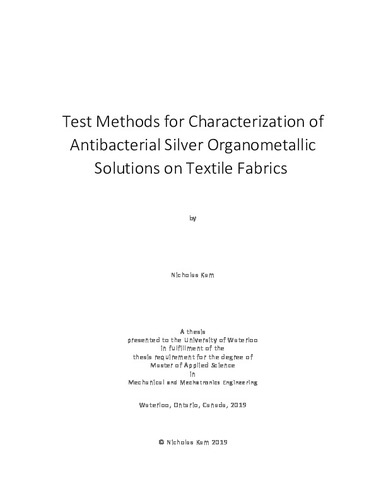UWSpace will be migrating to a new version of its software from July 29th to August 1st. UWSpace will be offline for all UW community members during this time.
Test Methods for Characterization of Antibacterial Silver Organometallic Solutions on Textile Fabrics
| dc.contributor.author | Kam, Nicholas | |
| dc.date.accessioned | 2020-01-15 16:34:02 (GMT) | |
| dc.date.available | 2020-01-15 16:34:02 (GMT) | |
| dc.date.issued | 2020-01-15 | |
| dc.date.submitted | 2019-11-15 | |
| dc.identifier.uri | http://hdl.handle.net/10012/15465 | |
| dc.description.abstract | Antimicrobial agents have been incorporated into textile fabrics to inhibit the growth of undesirable odor-producing bacteria. In recent years, a variety of consumer textiles have been commercially released that utilize active chemical agents to disrupt the working function of bacterial cells, e.g. Stahylococcus aureus, Pseudomonas aeruginosa, and Escherichia coli. As consumer products it is essential that testing be preformed to evaluate the overall efficacy of an antibacterial fabric surface. This thesis was prepared in collaboration with Microbonds, Canada, and involves the investigation of their odor eliminating spray Go.Fresh. The primary antibacterial agent is silver complexed with organic molecules—organometallic silver—dissolved in an aqueous solution. Silver is an excellent antibacterial due to its low toxicity to humans. Application of the organometallic in aerosol form enables fine dispersal of the solution onto any textile material. Characterization and antibacterial efficacy tests were preformed on candidates for the commercial silver organometallic solution (SOS). This thesis outlines scientific methods used to evaluate SOSs in application. Test methods are divided into three sections: characterization of the organometallic silver via standard analytical techniques; development of metrics for staining on fabric at various organometallic concentrations; and measurement of antibacterial efficacy on treated fabrics. Chemical analysis via energy dispersive X-ray (EDX) confirmed the presence of silver on treated fabrics. Concentration measurements on fabric via inductively coupled plasma optical emission spectrometry (ICP-OES) indicated a 49 % loss in silver from initially applied amounts. Staining on fabric was accurately measured using a Nix Pro colour sensor. Discolouration based on the CIELAB colour space was applied. Imperceptible changes in colour was generally observed in samples at silver concentrations below 100 ppm. Lastly, antibacterial properties of the SOSs were confirmed by minimum inhibitory concentration (MIC) tests that reported complete elimination of 99.9 % of bacteria. Accelerated methods proposed for antibacterial testing based on concentrations of adenosine triphosphate (ATP) correlated well with MIC results. Fabric samples treated with organometallic silver reported a 96.4 % reduction in ATP relative to an untreated control. Additional ATP tests showed comparable bactericidal power to that of standard copper surfaces. | en |
| dc.language.iso | en | en |
| dc.publisher | University of Waterloo | en |
| dc.subject | silver organometallic solutions | en |
| dc.subject | antibacterial | en |
| dc.title | Test Methods for Characterization of Antibacterial Silver Organometallic Solutions on Textile Fabrics | en |
| dc.type | Master Thesis | en |
| dc.pending | false | |
| uws-etd.degree.department | Mechanical and Mechatronics Engineering | en |
| uws-etd.degree.discipline | Mechanical Engineering | en |
| uws-etd.degree.grantor | University of Waterloo | en |
| uws-etd.degree | Master of Applied Science | en |
| uws.contributor.advisor | Mayer, Michael | |
| uws.contributor.affiliation1 | Faculty of Engineering | en |
| uws.published.city | Waterloo | en |
| uws.published.country | Canada | en |
| uws.published.province | Ontario | en |
| uws.typeOfResource | Text | en |
| uws.peerReviewStatus | Unreviewed | en |
| uws.scholarLevel | Graduate | en |

